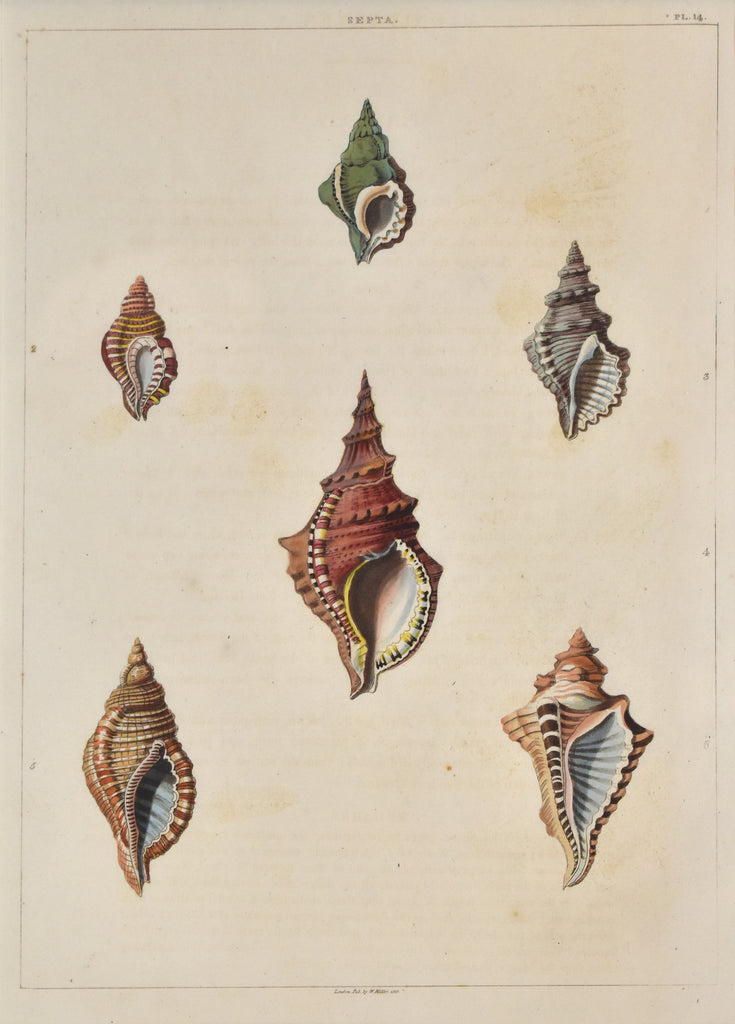-
Title: Septa, PL. 14
-
Author: George Perry
-
Date: 1811
-
Medium: Hand-colored aquatint
-
Condition: Very Good +
-
Inches: 9 3/4 x 13 1/2 [Image]
-
Centimeters: 24.77 x 34.29 [Image]
-
Product ID: 3010036
George Perry, British naturalist and expert in malacology (the study of mollusks), published two major natural history works during his lifetime. One of them Arcana; or the museum of natural history, a richly-illustrated natural history magazine, was released in monthly installments from January 1810 to September 1811. He published his other major work, Conchology, or the natural history of shells, in 1811. The majority of Perry’s contemporaries ascribed to Linnaean taxonomy, the system of natural classification devised by Swedish botanist Carl Linnaeus in the eighteenth century. However, Perry adhered to the taxonomic system and theories of evolution popularized by French naturalist Jean-Baptiste Lamarck. As a result of these dissenting views, Perry’s work was deliberately ignored at the time by many of his fellow British naturalists. Very little is known about him today.
Includes the following page of corresponding descriptive text:
BIVALVES. PLATE LX.
Genus. SEPTA.
Character. Shell spiral; the spire and body intersected by membranaceous septae or divisions, placed irregularly and alternately on the body and spire; the first of these forms the maxilla oris, the rest are placed upon the body and spire; the beak variously bent. The septae are of a different colour from the rest of the shell.
Species.
No. 1. Septa Parkinsonia. Shell olive-coloured, and angulated; the mouth white, with a tuberculated edge, inclining to gray. This shell being hitherto undescribed, I have taken the liberty of naming it Parkinsonia, in honour of Mr. James Parkinson, of Hoxton, author of a curious Work upon the natural history of fossils. It is a native of the coast of New Holland.
No. 2. Septa Scarlatina. Shell variegated with scarlet, yellow, and white streaks; spire round and blunted; the mouth narrow and small. A native of Amboyna and the Eastern Seas.
No. 3. Septa Spengleri. Shell brown, sometimes covered with a green epidermis; spire tuberculated; mouth deeply ridged, and white. A native of New Holland.
No. 4. Septa Rubicunda. Shell red, beautifully streaked with white and brown marks; spire tuberculated; the mouth denticulated, and having two white teeth on the inner side. This shell resembles the Murex tritonia of Linnaeus; but is much smaller. It is a native of New Holland.
No. 5. Septa Rubecula. Shell variegated, brown, red, and white; the mouth having a rounded channel at the top, like the rest of the Septae, only more distinctly marked. This shell is a native of the South Seas, and has been mistakenly called a Murex by some authors who have delineated and described it.
No. 6. Septa Triangularis. Shell reddish brown, variegated with white and dark brown marks; its singularly angulated form, and particularly its angular cheek, will easily distinguish it from the rest of its congeners. It is a native of the Southern Ocean.
REMARKS
The various forms of the curious genus are very striking, and sometimes apparently opposite to each other; nevertheless, if we take the following character as our guide, namely, membranaceous folds, longitudinally placed, one of these forming the cheek of the mouth and the rest of the folds irregularly placed, all the difficulty of classing them will cease at once. At the same time it will be found that these shells have a natural relation to each other in many more respects, such as the folds being painted generally of a different colour from the rest of the shell, the indented notch, and tooth faintly marked at the top of the mouth. This general relationship will fully justify the accurate Conchologist in separating them from the Murex, and all other genera hitherto described.


